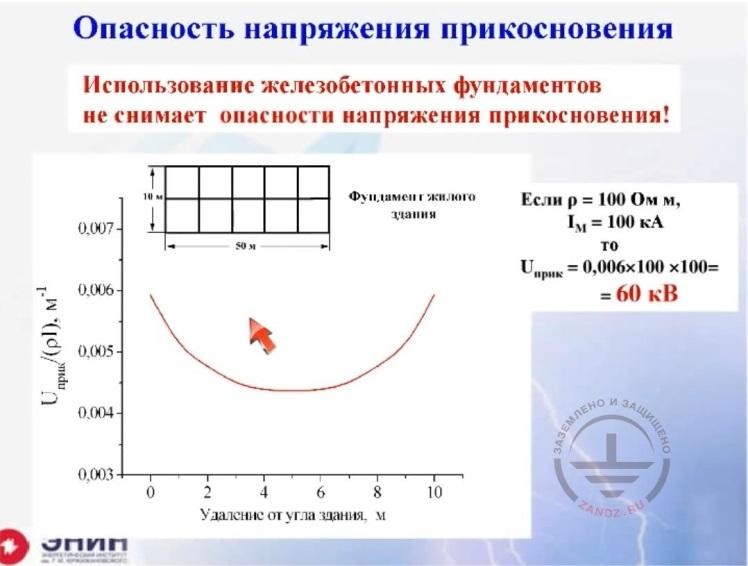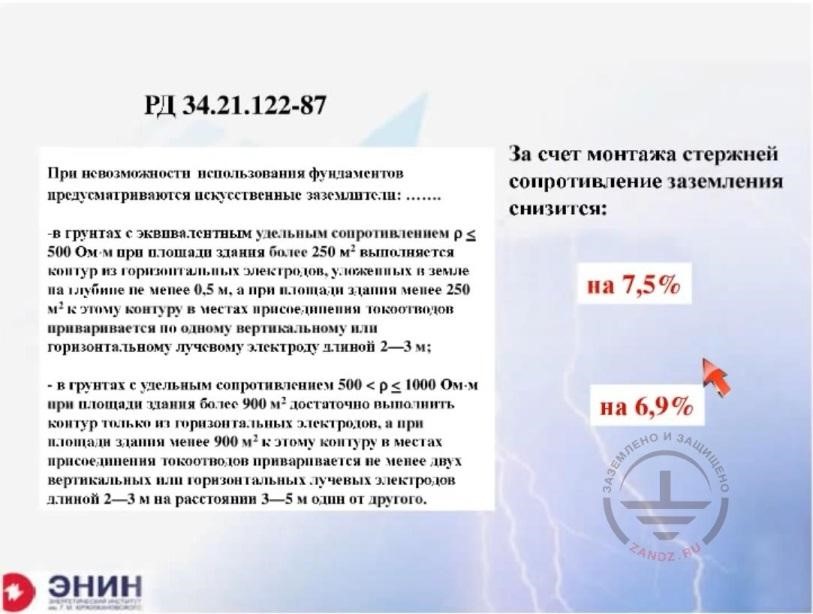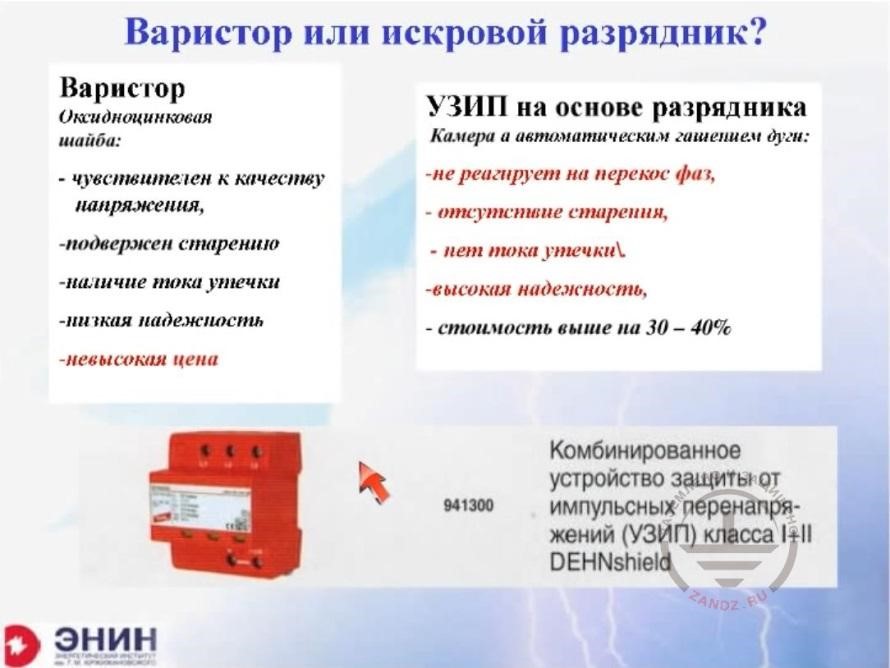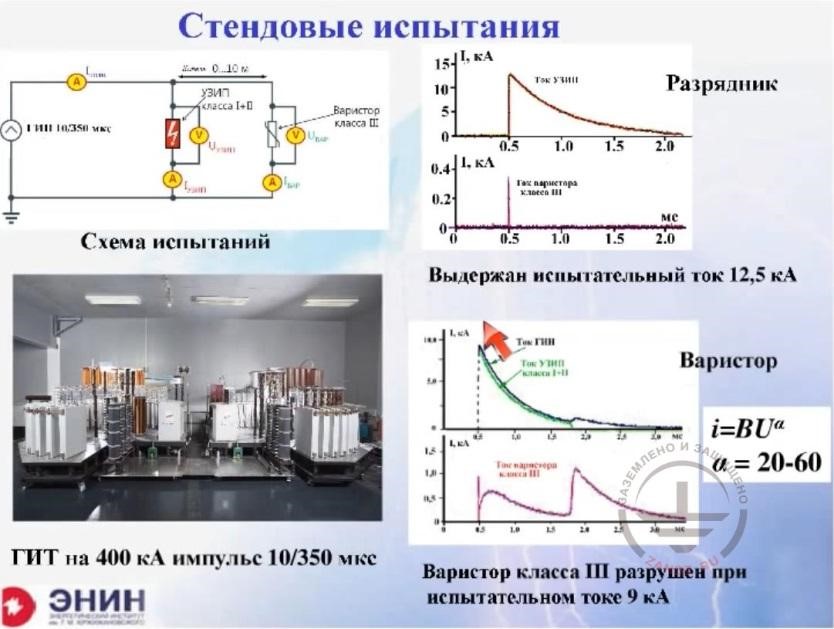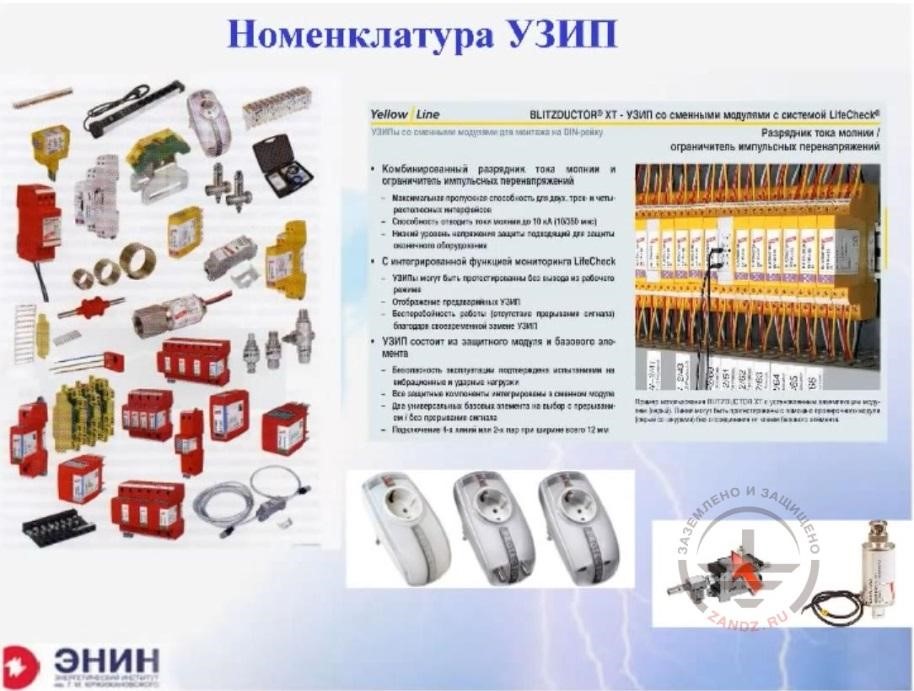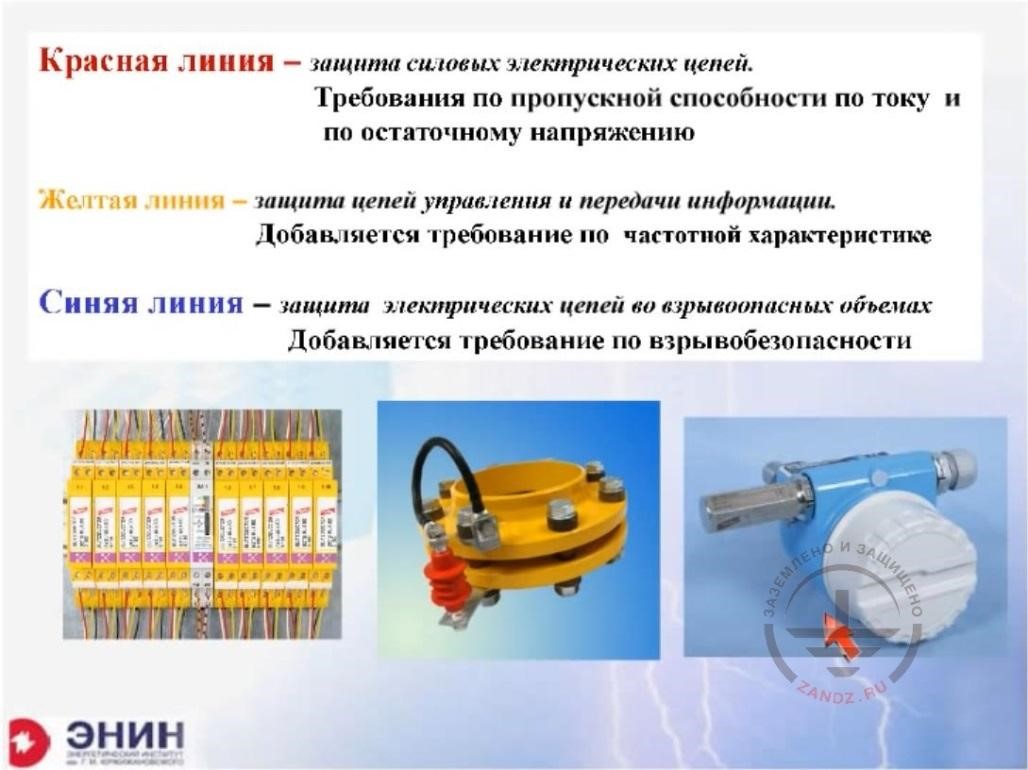The second webinar of Grounding and lightning protection: answing frequently asked design questions series
Webinar text. Page 3
Quick navigation through slides:
<< Page 1:
1. Private housing protection
2. RD 34.21.122-87 regulatory requirements
3. SO-153-34.21.122-2003 requirements
4. RD 34.21.122-87 minimum requirements
5. Expected number of direct lightning strikes
6. Influence of adjacent structures
7. Electromagnetic effects of lightning
8. Lightning proofing capacity of buildings
9. Typical urban development
Page 3:
19. Lightning grounding of large buildings
20. Touch voltage hazard
21. RD 34.21.122-87
22. Internal lightning protection
23. Varistor or spark gap
24. Bench tests
25. SPD list of items
26. Surge protection devices
27. questions and answers
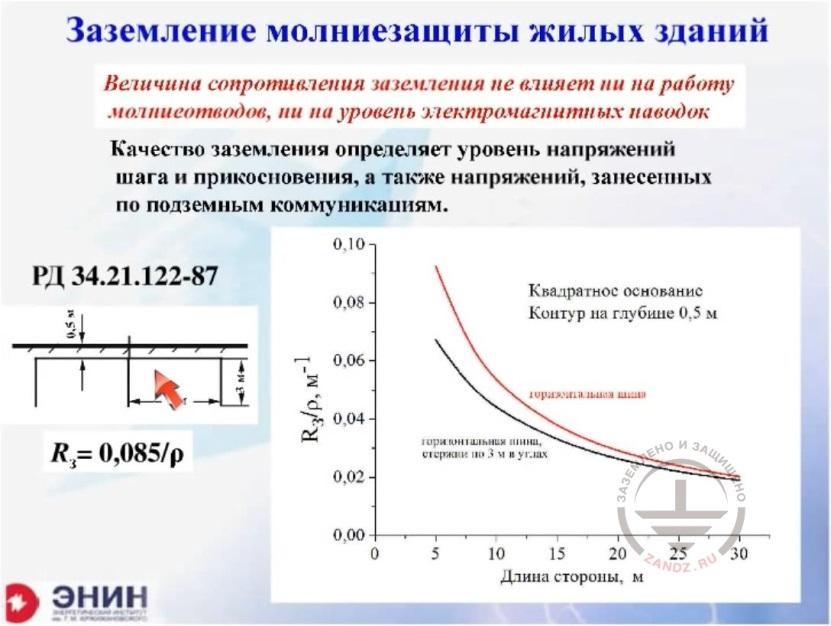
Lightning protection grounding of large buildings
| RU | EN |
| Заземление и молниезащита жилых зданий | Grounding and lightning protection of residential buildings |
| Величина сопротивления заземления… | The value of grounding resistance affects neither the lightning rod operation nor electromagnetic interferences |
| Качество заземления определяет уровень напряжений…. | The quality of grounding determines the level of touch and step voltage, as well as voltage transmitted over underground utility systems. |
| Квадратное основание | Square foundation |
| Контур на глубине 0,5 м | Loop at a depth of 0.5 m |
| РД 34.21.122-87 | RD 34.21.122-87 |
| Горизонтальная шина | Horizontal bus |
| Горизонтальная шина, стержни по 3 м в углах | Horizontal bus, rods at the corners, 3 m each |
| Длина стороны, м | Lateral length, m |
What requirements do standards specify for the grounding in Russia? A thermal ground electrode system is required by RD 34, for example. You can calculate its grounding resistance by dividing this number by the soil resistivity value. Oh, excuse me, there's an error in this slide. The multiplication sign should be here instead of the division sign. I am sorry. Please correct your records and put the multiplication sign here. So, if your house has a foundation and the foundation is made of reinforced concrete, then the foundation will have a significantly smaller grounding resistance value than required by the RD 34 virtually at all times. And if your building, even a single-family house, has a reinforced concrete foundation, you can forget about the grounding resistance and use the rebars as lightning protection grounding.
| RU | EN |
| Использование железобетонных фундаментов… | The use of reinforced concrete foundations does not eliminate the hazard of touch voltage! |
| Фундамент жилого здания | Residential building foundation |
| Удаление от угла здания | Distance from the building corner |
| Если ρ=100 Ом м…. | If ρ=100 Ohm m, IM=100 kA then Utouch=0006x100x100=60 kV |
But if you don't have a foundation like that, then you need to make your own ground loop. And I will talk about it later. But before that, I'll tell you another thing. Neither a reinforced concrete foundation nor structures specified in RD 34 decrease the risk of touch voltage. Touch and step voltages remain very large. They remain high even if you have a very good soil, for example, 100 per meter, i.e. close to the soil humus. And even in such a good soil, touch and step voltages are close to a value of 60 kV for your grounding. How should you deal with that? You can certainly reduce the grounding resistance. But even if you reduce the grounding resistance, you will not be able get away from this figure far enough. Imagine that you've reduced the grounding resistance by half. Then the touch voltage will be reduced to 30 kV instead of 60 kV. Yes, this value is better of course, but the person will feel a sufficiently serious shock anyway. What do you have to do this case? It is recommended that you should arrange a blind area along the perimeter of the building using a material that does not absorb moisture, if this is possible. The simplest material is asphalt. If you make the blind area one meter wide or so, and pave it with asphalt, then the risk of touch voltage will decrease significantly. And this situation is extremely favorable. Not so long ago a company I know made such a system in a residential complex for a VIP, a person known on a governmental level.
| RU | EN |
| РД 34.21.122-87 | RD 34.21.122-87 |
| При невозможности использования… | If it is impossible to use the foundations, then artificial ground electrode systems are provided:….. - in the soils with an equivalent resistivity of ρ≤500 Ohm*m when the building area exceeds 250 m2, a grounding loop is made of horizontal electrodes laid in the ground at a depth of at least 0.5 m; and if the building area does not exceed 250 m2, one vertical and one horizontal beam electrode 2 to 3 meters long are welded at each point of down conductor connection; - in the soils with a resistivity of 500<ρ≤1000 Ohm*m and the building area of over 900 m2, it is sufficient to make a ground loop only with horizontal electrodes; and if the building area is less than 900 m2, then at least two vertical or horizontal beam electrodes 2 to 3 meters long are welded at the down conductor connection points at a distance 3 to 5 meters from each other. |
| За счет монтажа стержней… | The rods will decrease the grounding resistance by: 7.5% 6.9% |
And now I want to draw your attention to the following. This is what written in RD 34: if you do not have a reinforced concrete foundation, then you need to arrange a ground loop along the building perimeter. Such a ground loop shall be made of a tape laid at a depth of 0.5 - 0.7 meters along the entire perimeter of the building. It would be good to lay it under the blind area to avoid the step and touch voltages. But the standard also requires the follows: if the perimeter has a certain length, then a simple horizontal tape is enough. But if the length of the perimeter is less, then it is necessary to lay a mesh in the corners and then drive metal rods having a length of 3 to 5 m. These mysterious rods are mentioned in almost every regulation. They are specified in PUE and RD 34. Buth the question is: do such rods help a lot? We've made special calculations to check that. If I make a loop along the perimeter of the building, and then drive the rods, what will happen then? The effect of these rods on the groundng resistance is at the level of 5 to 10%. And you cannon obtain the lower grounding resistance using the rods. The effectiveness of such vertical electrodes at the corners of your building is extremely low. So I don't know why RD 34 requires this kind of vertical grounding. If you need to make the grounding resistance significantly lower, then make special design calculations. ZANDZ.com project can help you with that. This company has software capable of calculating all the things you need.
So, I guess you understand. It is almost impossible to carry out a reliable lightning protection without special software. Like it or not, but software is more and more actively involved in the design process.
- So, do you have any questions? Or shall we continue? Can I? Do you want to ask a question? You are welcome!
Hello, dear participants, my name is Nadezhda. I'll help Mr. Bazelyan by reading your questions regarding the external lightning protection. As far as I understand, we are starting our questions and answers session.
- No! No, I will go on with the lecture.
- What standards lay a basis for calculations made by the software you’ve mentioned? That's the question we received.
- What are the standards?
- Yes.
- None of the standards specify methods that can be used by the software. But the software I was talking about, the software offered by ZANDZ.com project was developed as follows. Protection zones described in RD 34 and SO 153 standards are based on statistical methodology developed at the Krzhyzhanovsky Institute. It is the institution I represent. The statistical methodology has been approved by relevant regulatory agencies. And the software is based on the methodology, which was used to calculate protection zones specified in the national regulations. This statistical methodology has quite a complicated philosophy, but the software is simple, so we will continue to offer it.
- Yes, we also have a question about the protection of private houses. If I install a catenary wire, do I also have to install a mesh cage?
- I’m repeating it now and will continue repeating it many times again. No mesh cage will protect your roof from a lightning strike. The mesh cage is required by our regulations, so we cannot avoid its installation if no other air terminals are installed. But if any other air terminal is present, such as a catenary wire I was talking about during our today's seminar, then no mesh cage is necessary. You should not install two types of air terminals at once. If there is a catenary wire and it provides the desired protection area, then no mesh is needed. And no one can demand such a mesh cage from you. That's for sure.
The same thing concerns the grounding: how can you prove that a reinforced concrete foundation provides the reliable grounding?
- This is a great question. It is quite a remarkable question and there is quite a clear answer to that. In Russia (in the Soviet Union to be precise), roofing is and was made not only from reinforced concrete. There was a time when I seriously studied the behavior of concrete in the soil. Concrete is a hydrophilic material. It absorbs moisture from the soil. As a result, after about two months of being buried in the ground, the moist reinforced concrete obtains a specific resistance that does not differ from the grounding resistance of the surrounding soil. The proof was obtained purely by experiment. There are no theoretical tricks here. So it turns out you have reinforcement bars laid not in the concrete, but virtually directly in the ground. And it is easy to calculate the grounding resistance of the rebars. So, if you take a foundation of 10 x 10 m, the grounding resistance ensured by that foundation will be lower than that of the thermal grounding specified in the RD 34. Therefore, the use of foundations as grounding devices is indisputable, subject to certain limitations. There are two of them, actually. The first limitation is this one. If for some reason you've protected your foundation with an epoxy compound, then moisture cannot penetrate the concrete, so the concrete will not become conductive. And in this case, you can assume that you do not have a foundation as a grounding device at all.
And the second limitation is this. If you build your foundation in the dry sand, i.e. moisture content is less than 3% meaning there's virtually no moisture at all, and moisture never comes from any source whatsoever, then again the foundation cannot perform the functions of a grounding device. So there are only two limitations. In all other cases, you can use a reinforced concrete foundation as a grounding device.
Here, we have another question about ...
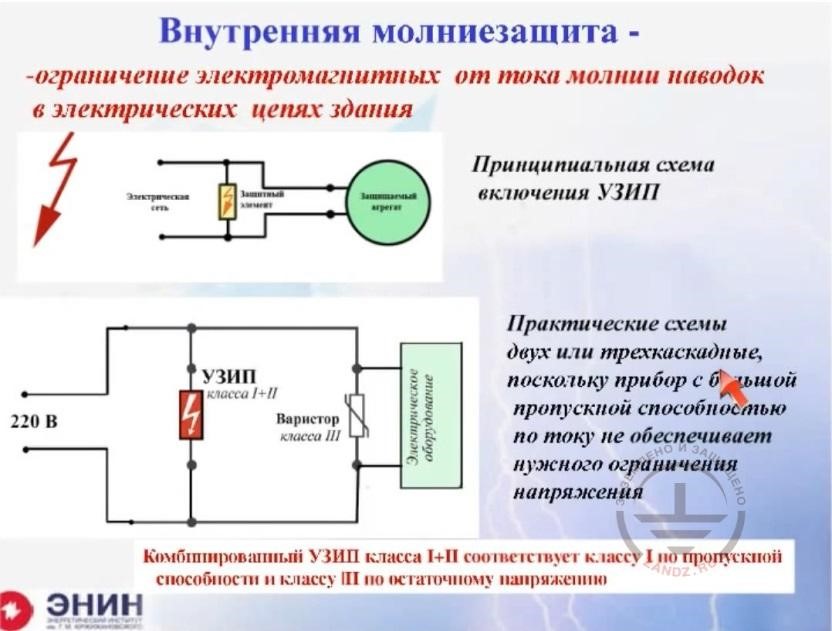
Internal lightning protection.
| RU | EN |
| Внутренняя молниезащита - | Internal lightning protection - |
| - ограничение электромагнитных наводок от тока молнии … | - limits electromagnetic interferences from the lightning current in electric circuits inside building |
| Принципиальная схема включения УЗИП | SPD connection diagram |
| Электрическая сеть | Electrical grid |
| Защитный элемент | Protective element |
| 220 В | 220 В |
| УЗИП класса I+II |
SPD class I+II |
| Варистор класса III |
Varistor class III |
| Практические схемы двух или трехкаскадные… | Real-life circuits are two- or three-stage, as a device with a large current throughput will not decrease the voltage to a desired level |
| Электрическое оборудование | Electric equipment |
| Комбинированные УЗИП класса I+II… | Combined class I+II SPDs correspond to Class I by throughput and Class III by the residual voltage |
So, we’re coming back to the internal lightning protection. What is the idea behind the internal lightning protection? You have a power line affected by the lightning (look, I'm drawing an arrow to show the lightning). Here, you have the lightning strike close to the power line, and it induces the high voltage. And you have your home appliances here. These home appliances will be damaged by electromagnetic interferences, and this may cause a fire in the house. And you have a component installed here that limits the effect of the voltage surge. This voltage limiter is called SPD. Usually, it should do two things. First, it must pass the lightning current, which branches off the wire, through itself. And second, the residual voltage in this element should be safe for the appliances. Usually, a combination of both conditions cannot be achieved. Therefore, the following thing is often done: an SPD capable of passing the lightning current is installed, but it cannot reduce the surge voltage completely. Another SPD is installed downstream. It is not that powerful, but it is capable of decreasing the surge voltage to a completely safe level. Such a system to limit the surge is perhaps typical in residential and office buildings.
| RU | EN |
| Варистор или искровой разрядник? | Varistors or spark gaps? |
| Варистор | Varistor |
| Оксидноцинковая шайба | Zinc oxide washer |
| - чувствителен к качеству напряжения | - sensitive to voltage quality |
| - подвержен старению | - subject to ageing |
| - наличие тока утечки | - leakage current is present |
| - низкая надежность | - low reliability |
| - необходимость разъединителя | - disconnect device is necessary |
| - невысока цена | - low price |
| Узип на основе разрядника | Spark gap SPD |
| Камера с автоматическим тушением дуги | Automatic arc extinguishing chamber |
| - не реагирует на перекос фаз | - does not sensible to phase distortions |
| - отсутствие старения | - not subject to ageing |
| - нет тока утечки | - high reliability |
| - высокая надежность | - high reliability |
| - работа без разъединителя | - no disconnect device is needed |
| - стоимость выше на 30-40% | - 30-40% more expensive |
| Комбинированное устройство защиты от перенапряжений… | A combined Class I+II SPD manufactured by DEHNShield |
Such urge limiters can be based on different components. They can be made using the varistor, a material that decreases its resistance very rapidly when the current increases. And can they can be made on the basis of spark gaps. The spark gap breaks down, and the arc short-circuits the electrical circuit. And then the arc is extinguished by a natural blowing that occurs in the spark gap. The question is: which one is better? A varistor or a spark gap? This question has provoked the most severe disputes during the last lightning protection conference. What’s the crux of the matter? The varistor has a very big advantage — it's cheap. The spark gap is almost twice as expensive. Therefore, the question arises: is it worth to use spark gaps? It turns out, yes, and the reason is as follows. In Russia, we have a sufficiently low voltage quality in electrical networks. We may experience a phase imbalance, so instead of 220 volts, you can have a voltage of 250 volts or even 270 volts.
| RU | EN |
| ГИТ | ICG |
| ГИТ 10/350 мкс | 10/350 microseconds ICG |
| УЗИП класса I+II | Class I+II SPD |
| Разрядник | Spark gap |
| Ток УЗИП | SPD current |
| Ток варистора класса III | Class III varistor current |
| Мс | Ms |
| Схема испытаний | Test diagram |
| Выдержан испытательный ток 12,5 кА | Withstands 12.5 kA current |
| Варистор | Varistor |
| Ток УЗИП класса I+II | Class I+II SPD current |
| Ток варистора класса III | Varistor class III current |
A whole lot of research has been started, and I also took part in it. This was related to the fact that a high-voltage laboratory at DEHN +SÖHNE just made comparative tests of the varistors and spark gaps. These tests show the following thing: it turns out that the current-voltage characteristic of the spark gap after it has been broken down is very clear, and it is essentially zero. After the spark gap breaks down, the current almost completely stops flowing through the device. It is drastically reduced (here you see the current peak, then the spark gap brakes down and the current fall to a zero value). Both the power and the energy released in the varistor are practically zero. If you have a varistor-based SPD, then because of the different voltage-current characteristics of a powerful varistor and a low-voltage varistor, you encounter the following: despite the fact that the power varistor limits the surge, the current continues to flow through your low-current varistor, and this is a significant current. This, in fact, determines the protection in the end. And this varistor is falling apart. So the choice turns out to be clear. If you want your protection to be reliable and you can afford that, then you have no other choice but to install an SPD based on the spark gap. It is a very reliable and long-lived element, which is not subject to any aging and does not react to the low quality of voltage in an electrical grid.
| RU | EN |
| Номенклатура УЗИП | SPD product range |
Today, an enormous amount of SPDs of different types are available. The devices I've shown you here (they are colored in red) limit the surge voltage in your circuits, but this is absolutely not enough for your home and office. You need to limit the surge in low-voltage networks that carry information. The examples of such circuits include a network between computers, a security system along the perimeter of your building, or various automation devices. For this purpose, there is a so-called yellow line of devices, which is capable of protecting dozens, if not hundreds, of different devices.
| RU | EN |
| Красная линия… | Red line - power transmission line protection. Requirements for current throughput and residual voltage |
| Желтая линия… | Yellow line – control and information transmission circuit protection. Frequency characteristic requirement is added |
| Синяя линия… | Blue line – protection of electric grid in explosive areas. Intrinsic safety requirement is added |
And finally, there is another line of devices. For example, DEHN+SÖHNE says it does not offer the third line of SPDs. They offer only two lines. But I always say that in fact there are three lines of SPDs. Because the third line of devices is intrinsically safe SPDs. It's the blue line. These intrinsically safe SPDs can be put in gas-polluted areas, where there may be an explosive concentration of gas. And sometimes, it is necessary to install such devices in residential and office buildings. I can tell you where. For example, you have a boiler room in the house. A gas boiler is installed in the room. The gas boiler can always be subject to gas leaks, and then you have to put intrinsically safe elements there. So there will be blue-line SPDs you need to install.
Questions and answers session
- Thank you. So before moving on to the questions, I'd like to remind you that we've recorded this webinar on video, so you will be able to receive it by e-mail if you complete the assessment questionnaires. A link to the questionnaires will appear in the chat now. And you must specify your e-mail addresses in the questionnaire. Here's the link, please fill in the questionnaires. As for the questions, let's start from the end — from the SPDs. There were questions on how to choose them.
-How to choose SPDs? You know, I do not want to answer this question at all. And the reason is that I believe the choice of SPDs is serious enough to hold a separate seminar. And if you do not mind, let's dedicate the next seminar to SPDs. We'll analyze what to do with them from the very start. How to install them. How to choose them. How to mount them. How to operate them. Especially since a number of firms, including the company I cannot help but advertise, are ready to invite you to a seminar where you will learn how to mount the SPDs. And as far as I understand, it costs virtually nothing. You will only need to pay for the trip to Bavaria.
- Another question is: how exactly spark gap decrease the current?
- Unfortunately, despite the fact that our seminar is interactive, I cannot draw on the screen, so I'll try to explain that verbally. Imagine that there is a spark gap between the phase conductor and the ground. There is an insulating gap about 1 mm long.
Now, what's next? After that, the lightning disappears and so does the surge. But a voltage of 220 volts remains in the circuit. And this voltage of 220 volts is sufficient to maintain the arc. Your short circuit would have stayed forever, but the following circumstances prevent this. The arc decomposes the walls of a very dense chamber where it was generated. The high pressure occurs, and a resulting gas stream blows the arc out. And as a result of the natural blowing the arc is extinguished. The SPD goes back to idle. This is what happens in the spark gaps. As for varistors, they work on the principle of transient contacts in the zinc oxide. The material heats up, so the contact resistance drops and you see a decrease in the varistor voltage. But unfortunately, the voltage drops to the much smaller values than in the case of arc, so the spark gap is always more reliable than the varistor-based protection, as experience shows. Anyway, varistors are widely used, and I'd like to emphasize once again they can be several times as cheap.
- Great. Then there's a question about grounding devices and reinforced concrete structures. How do such structures behave in the permafrost soil?
- The behavior is like this. Not a single structure can behave well in the permafrost soil. Because if you do not have moisture and there is no electrolyte, then the grounding resistance naturally becomes very high. As for the lightning protection, the situation is simple. Thunderstorms only happen in summer. And in our region, where we have residential houses, the ground thaws out to a depth of about 1 meter. And then we obtain moisture, which allows us making a grounding device. But very often, in places with the permafrost soil, it is necessary to make deep grounding conductors that penetrate down to the non-frozen layers, in order to ensure the grounding resistance required for your electrical installations. Maybe this is not necessary for lightning protection, but it is certainly necessary for the electrical safety. And such ground electrode systems are actively used in permafrost zones.
- So, there were a lot of questions about the software. Can the software calculate the design of air terminals, that is, their height, the length of the catenary wires etc.?
- What is the software capable of? I represent a group of specialists who have developed the software, so I can tell you the following. The software allows you to arrange any number of air terminals of any type and height (of course, other than active lightning rods, which we do not recommend to use in any case). Again, it allows you to place a device of any height, shape, and ratio. And after such an arrangement is made, you can determine the reliability of protection of your structure or its fragment. And what's more, you will immediately see that your facility is protected in excess, so you can remove a lightning rod or make it lower. You can also see that your facility is not enough protected, so you can install another type of air terminal and recalculate your protection. This is done quickly. The software works interactively with the user. And our hands-on experience shows that the software is user-friendly for the design calculations.
- So, we are through with the question. More questions arrive about what to choose - SPDs or external lightning protection?
- If Nadezhda formulated that correctly, the question is what to choose - SPDs or external lightning protection. I'll tell you that it sounds like: I'm going on a hike to a desert. What should I take with me? A piece of bread or a can of water? You have to take the bread and a can of water because you'll become both thirsty and hungry. The external and internal lightning protections do not replace one another. The external lightning protection ensures the only thing: it protects your building from the direct lightning strike. This is the function of external lightning protection. If you do not install an external lightning protection, the lightning strike can, for example, pierce your metal roofing or complex modern roofing, and damage it. This is only one of several functions the external lightning protection performs. And the internal lightning protection is installed in order to reduce the surge, which damages circuits and equipment in the building.
- Yeah, OK. And there's a question about grounding devices: are there any requirements for the resistance of grounding devices and is it feasible to combine them with the electrical installation?
- Can I start from the end? We have the PUE standard. And the PUE states that grounding devices of any designation should be connected into a single ground loop. And if PUE was definite about it, no one would have any questions. But PUE is not definite about the matter. There is no a full stop in the sentence in the PUE, there's a comma instead. And after the comma, PUE continues: "except when due to technological reasons, ground electrode systems should be separated from each other". It incredibly complicates everything in cases when, for example, you make a ground loop for a building, install a lightning rod near it, and this lightning rod has its own ground electrode system not connected to that of the building. A conclusion whether it is good or bad should be made separately in each case. And the separation of the ground electrode system and the facility from each other does not necessarily mean that the lightning current does not get from one ground electrode system to the other. This is a very serious matter, which in some cases requires a very careful consideration. And if you don't mind, I would devote the third seminar entirely to grounding devices. Now, regarding the requirements. Unfortunately, none of the Russian normative documents (and there are two of them - RD 34 and SO 153) have any specific requirements for the grounding resistance at all. The only thing that the RD 34 has is the typical design of a ground electrode system. And we will study that typical design in all details during one of our next seminars. I can tell you the design is so bad that you must exert every effort to invent something worse than this. But in excuse of Russia's regulatory framework I have to say that if I deep-dive into the regulations of the International Electrotechnical Commission, I'll find nothing good there either. And we will analyze that with you as well. So how to deal with the situation? We won't probably solve the problem because we have no legislative power. I will try to teach you how to bypass this situation.
- Well, then we will postpone questions about the grounding device for a special webinar so that we could return to the lightning protection now. If for example, you have a land plot built-up with single-family houses, and there are many houses there without the lightning protection, will the installation of an external lightning protection on one house increase the risk of lightning strikes to others?
- Do you mean the risk for neighboring houses?
- I mean this exact house and the neighboring ones.
- Once again, the situation is like this. The vast majority of single-family houses have no lightning protection at all. No lightning protection, absolutely. And our regulations do not prohibit this. In fact, if we follow our regulations, we can leave virtually any building without lightning protection, with a few exceptions. The question is this: if I make the lightning protection, then how I benefit from it? I will answer this question if you want. I am not a resident of Moscow. I live in a suburb, in a small private wooden house, which I inherited from my parents. And there isn't a single house on my street that has the lightning protection installed. A couple of years ago, the lightning struck not far from our street. So I went along the street asking my neighbors what happened to them. It turned out that the losses caused by the lightning strike were up to 100,000 rubles. I lost about 10,000 rubles myself. Fortunately, the strike was not very close, so no building caught fire due to internal short circuits. All external automatic circuit breakers worked fine and cut off all the short circuits. So only home electronic appliances burned down. You know, I would not dare to leave my house with no external lightning protection at all. But I remember very well that the external lightning protection does not protect against the surge. And if I really want to protect my house, I have to add SPDs to the external lightning protection. When is an external lightning protection not necessary? In situations where there are, for example, trees or tall buildings next door to your building and they can play the role of natural lightning rods. For example, pine trees grow in my yard, so I do not install lightning rods on my roof. As for the protection of the internal electric circuits, you will hardly get along without modern SPDs. You know, on my request, my colleagues from DEHN+SÖHNE have calculated how much the most expensive internal lightning protection would cost if I used the highest-quality equipment. That is if I use SPDs that meet all the requirements whatsoever. The result was a big figure, but not a deadly one. The figure was somewhere in the range of 20,000 rubles. You see, when you build a house and spend several million rubles on it (and unfortunately, the construction costs are in this range today) I would not save on the lightning protection. In the Western countries, this is out of the question because if you do not install the lightning protection, then your insurance will sky-rocket, and you'll immediately rush to Moscow to order your lightning protection as it is cheaper here than in Germany.
- Going back to SPDs, how is the arc extinguished in a vacuum gap?
- How is the arc extinguished in a vacuum gap? You know, vacuum gaps are never used to protect power equipment. These are the red-line gaps I was talking about. Vacuum gaps are placed only in control and automation circuits. These are mostly obsolete appliances, where there is no follow current so there's no need to extinguish the arc. It disappears on its own because the current is virtually zero there, so it does not support the arc. It just dies out naturally after its transition through zero. No one has ever put a vacuum gap in circuits where an accompanying power current is present.
- It's clear. The attendees ask you to repeat the name of the software once again.
- You know, this is the question for ZANDZ.com project, as this is them who decide how to call the software. We have handed over all our developments to them, and they will give the name, define user policies and do all the rest. I do not interfere in this, as the only thing we did is gave them the software. Please feel free to contact them.- And here's the question about bolted connections. Do you have to check them before the storm season starts? Tighten them up or check their condition?
- You know what? According to Russian standards, we have to inspect the lightning protection systems once a year before the thunderstorm season. As far as I understand, systems offered by European firms meet the requirements of European standards for the quality of contact resistance and bolted joints. As far as I understand, they do not require such inspections. How to deal with situations when Russian standards contradict to the international requirements? Honestly, I do not know, so I'll put it this way: it is better to check the contact resistance before the thunderstorm season, at least selectively, the more so as it is not difficult to make the inspection. Especially as you have to check the grounding resistance before the thunderstorm season. You will get into the system anyway.
- It's clear. In general, the main questions are answered. So I ask the attendees to recall if I have missed any questions.
<< Previous Page
Slides 10 to 18
Do you have any questions left? Send them to our technicians and you will receive detailed and reasoned answers.
Useful materials for designers:
- Webinars with the leading industry experts
- Everything for the calculation of grounding and lightning protection
- Useful materials: articles, recommendations, examples
Related Articles:


